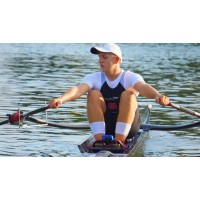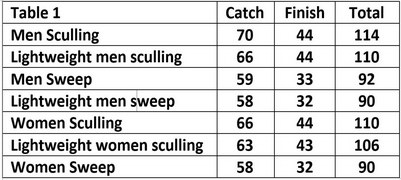BioRow‚ĄĘ Oar Angle Guides

BioRow‚ĄĘ Angle Guides is a tool for an easy, reliable and accurate MEASUREMENT and CONTROL of the catch and finish oar angles. They could be quickly installed on any boat without modification and removed in seconds if not needed. The angle setting procedure is accurate and requires only tape measure. They help to achieve better SYNCHRONISATION in a crew: rowers can hear the clicks when the oar shaft touches the metal guides, and they can synchronise their movements according to these sounds.
The oar angles could be defined in two ways:
1. The scale on the base (Fig.1)
could show approximate angles ¬Ī2deg, which depends on the thickness of the oar
shaft, the sleeve design and its position in the oarlock. In this case, the
base must be properly aligned during its installation: align the levers at zero
angle lines, then turn the base to align levers perpendicularly to the boat and
fix the base with a nut. |  |
| 2. For
the most accurate angles definition, the oar should be placed in the oarlock
with its handle end (Fig.2), to keep the same distance between the centres of
the pin and the oar shaft as it works in rowing (usually, 4cm at catch and 6cm
at finish, which is defined by the position of the sleeve in the oarlock). |  |
 | Put the oar shaft into contact with the vertical rod and measure the distance L from the line of pins to the point A, where the shaft crosses the centre line of the boat (Fig.3). The angle could be found using the attached Tables 2 and 3 using this distance L and the span in sculling or spread in rowing.
|
| Table
1 gives target angles for Olympic level rowers, which could be decreased by 3-5deg
for club rowers. |  |
To CONTROL the angles, the sequence
is reversed. Firstly, define your target catch and finish angles and find out
the distances L from the Tables 2 and 3. Then, mark point A on the boat
centreline at the distance L from the line of the pins and put an oar across
the oarlock and point A. Release the two bolts at the bottom of the lever, and
rotate it until the vertical rod touches the oar shaft from outside. Tighten
the two bottom bolts and check that the vertical rod is still in contact the
oar shaft.
BioRow‚ĄĘ Angle Guides are supplied as
a set of two units (cost £100 per set), enough to setup a pair or double. Two
sets are needed for a four and quad, four sets ‚Äď for an eight. The device is
lightweight (less than 160g) and could be quickly packed in a compact bag provided
(Fig.4,a). There are a number of versions of BioRow‚ĄĘ Angle Guides. The base could
be supplied in two options of the SAME price:
1. Stainless steels
low profile base (Fig.4, b) is the most durable and useful option (Its only
limitation is that it can’t be used for the finish angle in two-stay carbon
riggers).
2. Aluminium high profile base (Fig.4, c) could be used on any riggers types.

The vertical rods could be supplied
in three versions (Fig.5):
1. Plain aluminium
solid rods (Fig.5, a) is the simplest, cheapest solution, which would work in
the most of the cases.
2. Plastic rods
with springs (Fig.5, b) are more expensive (+£20 per set), but allow more
flexible setting of the angles. They would not brake, if you hit them with the
oar too often.
3. Foldable rods (Fig.5,
c) is the high-end solution and allow quick switching them ON/OFF in water, or
for storage in a boathouse (+£100 per set).

We do hope you will find the best configuration, enjoy using your BioRow‚ĄĘ Angle Guides, and row faster!
Please contact us at valery@biorow.com if you would like to order the Angle Guides.



